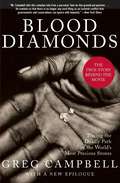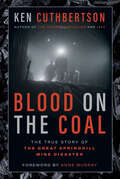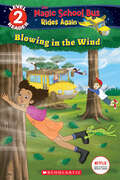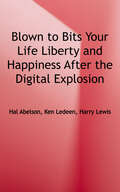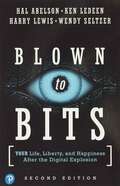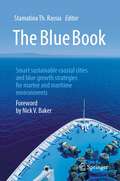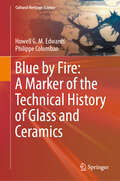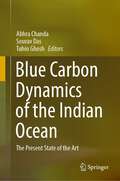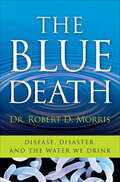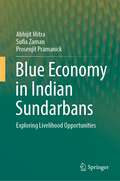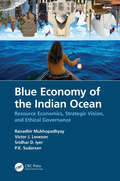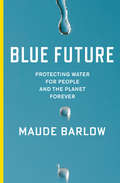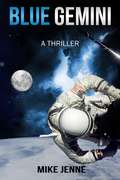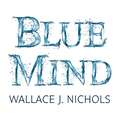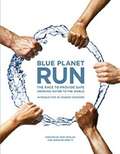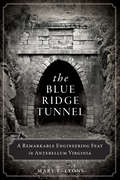- Table View
- List View
Blood Diamonds: Tracing the Deadly Path of the World's Most Precious Stones
by Greg CampbellFirst discovered in 1930, the diamonds of Sierra Leone have funded one of the most savage rebel campaigns in modern history. These "blood diamonds" are smuggled out of West Africa and sold to legitimate diamond merchants in London, Antwerp, and New York, often with the complicity of the international diamond industry. Eventually, these very diamonds find their way into the rings and necklaces of brides and spouses the world over. Blood Diamonds is the gripping tale of how the diamond smuggling works, how the rebel war has effectively destroyed Sierra Leone and its people, and how the policies of the diamond industry - institutionalized in the 1880s by the De Beers cartel - have allowed it to happen. Award-winning journalist Greg Campbell traces the deadly trail of these diamonds, many of which are brought to the world market by fanatical enemies. These repercussions of diamond smuggling are felt far beyond the borders of the poor and war-ridden country of Sierra Leone, and the consequences of overlooking this African tragedy are both shockingly deadly and unquestionably global. Updated with a new epilogue.
Blood in the Machine: The Origins of the Rebellion Against Big Tech
by Brian Merchant"The most important book to read about the AI boom" (Wired): The "gripping" (New Yorker) true story of the first time machines came for human jobs—and how the Luddite uprising explains the power, threat, and toll of big tech and AI today Named one of the best books of the year by The New Yorker, Wired, and the Financial Times • A Next Big Idea Book Club "Must-Read" The most urgent story in modern tech begins not in Silicon Valley but two hundred years ago in rural England, when workers known as the Luddites rose up rather than starve at the hands of factory owners who were using automated machines to erase their livelihoods. The Luddites organized guerrilla raids to smash those machines—on punishment of death—and won the support of Lord Byron, enraged the Prince Regent, and inspired the birth of science fiction. This all-but-forgotten class struggle brought nineteenth-century England to its knees. Today, technology imperils millions of jobs, robots are crowding factory floors, and artificial intelligence will soon pervade every aspect of our economy. How will this change the way we live? And what can we do about it? The answers lie in Blood in the Machine. Brian Merchant intertwines a lucid examination of our current age with the story of the Luddites, showing how automation changed our world—and is shaping our future.
Blood on the Coal: The True Story of the Great Springhill Mine Disaster
by Ken CuthbertsonThe riveting true story of one of Canada’s worst mining disasters, told in the voices of the men who survived itThey said it was the world’s deepest and most dangerous coal mine. Those who made that claim were probably correct. What is certain is that in October 1958, the Dominion Steel and Coal Corporation’s No. 2 colliery at Springhill, Nova Scotia, was a leading candidate for both those dubious distinctions. The mine was the proverbial “disaster waiting to happen.” And it did. Springhill was the quintessential one-industry town, whose existence depended on coal, a commodity with a dying market. And yet something far worse was soon to come. On the night of October 23, 1958, a “bump” in the mine—actually a small earthquake—shook the ground beneath the town. Seventy-five miners died and scores more were injured in what remains one of Canada’s worst underground disasters. The lives of the survivors were shattered, and Springhill would never be the same again. In compelling detail, Ken Cuthbertson tells the stories of three of the miners and one of the doctors who cared for them following the disaster. This remarkable book is based on historical documents and interviews, as well as new interviews with the last of the surviving miners and their loved ones. It is a story of heroism, sacrifice and the indomitable strength of the human spirit.
Blood World
by Chris MooneyEverything changed when scientists discovered the drug. It looked like the cure for aging, but all progress comes with a price tag. Now, eternal youthfulness will be paid for by the blood of the innocent. The blood of &“carriers&” is the most valuable commodity on earth. When treated with a new wonder drug, it cures disease, increases power, and makes the recipient a virtual superman. It also makes the carriers targets. Young people with the right genes are ripped from their families and stashed in &“blood farms.&”Ellie Batista became an LAPD officer specifically to fight this evil as a member of the Blood Squad, but her ambitions are thwarted—until the day she and her partner are ambushed during a routine stop. The resulting events plunge her into an undercover world more dangerous than she could have ever imagined.Because a madman has found a way to increase the potency of the blood to levels previously unimagined. As he cuts a bloody swath through the already deadly world of blood cartels, Ellie is the only hope to stop him before the body count explodes.
Bloodstain Pattern Analysis in Crime Scenarios (SpringerBriefs in Applied Sciences and Technology)
by Kacper ChoromanskiThis book introduces the core concepts of bloodstain pattern analysis that help to understand and make independent contributions to crime scenes accurately. It presents a bridge between new research results and the practical work field of crime scene investigation in bloodstain pattern analysis, by showing and detailing reports of two different scenarios. The scenarios presented have an extensive description of gathered evidence and are diversified with real crime scene photography and sketches. This kind of case report is rare in scientific books, but the author, as a researcher, has permission from the authorities to present the cases. The book finally concludes with the main problems of modern bloodstain pattern analysis and discusses the way forward.
Blowing in the Wind (Scholastic Reader, Level 2)
by Samantha BrookeBased on the new Netflix series The Magic School Bus: Rides Again , Ms. Frizzle's class trys to build a house that will not blow down.Next stop... The Magic School Bus heads to the forest to learn about aerodynamics. Ms. Frizzle's class is putting on a play of The Three Little Pigs.The kids want to build a house for their play that even a super-powered fan can't blow down. So Ms. Frizzle and her Magic School Bus take the class to the forest to learn how trees stand up to strong winds. Will these little pigs get blown over or learn to stand strong? Includes stickers!
Blown to Bits: Your Life, Liberty, and Happiness After the Digital Explosion
by Hal Abelson Ken Ledeen Harry Lewis"For thousands of years, people have been saying that the world is changing and will never again be the same. Yet the profound changes happening today are different, because they result from a specific technological development. It is now possible, in principle, to remember everything that anyone says, writes, sings, draws, or photographs. Everything. If digitized, the world has enough disks and memory chips to save it all, for as long as civilization can keep producing computers and disk drives. Global computer networks can make it available to everywhere in the world, almost instantly. And computers are powerful enough to extract meaning from all that information, to find patterns and make connections in the blink of an eye. <p><p>In centuries gone by, others may have dreamed these things could happen, in Utopian fantasies or in nightmares. But now they are happening. We are living in the middle of the changes, and we can see the changes happening. But we don't know how things will turn out. Right now, governments and the other institutions of human societies are deciding how to use the new possibilities. Each of us is participating as we make decisions for ourselves, for our families, and for people we work with. Everyone needs to know how their world and the world around them is changing as a result of this explosion of digital information. Everyone should know how the decisions will affect their lives, and the lives of their children and grandchildren and everyone who comes after. That is why we wrote this book." - By the Authors
Blown to Bits: Your Life, Liberty, and Happiness After the Digital Explosion
by Hal Abelson Ken Ledeen Harry Lewis Wendy SeltzerWhat you must know to protect yourself today. <p><p>The digital technology explosion has blown everything to bits--and the blast has provided new challenges and opportunities. This second edition of Blown to Bits delivers the knowledge you need to take greater control of your information environment and thrive in a world that's coming whether you like it or not. <p><p>Straight from internationally respected Harvard/MIT experts, this plain-English bestseller has been fully revised for the latest controversies over social media, “fake news,” big data, cyberthreats, privacy, artificial intelligence and machine learning, self-driving cars, the Internet of Things, and much more. <p><p>Discover who owns all that data about you―and what they can infer from it. Learn to challenge algorithmic decisions. See how close you can get to sending truly secure messages. Decide whether you really want always-on cameras and microphones. Explore the realities of Internet free speech. Protect yourself against out-of-control technologies (and the powerful organizations that wield them). <p><p>You will find clear explanations, practical examples, and real insight into what digital tech means to you--as an individual, and as a citizen.
Blowout
by Byron L. Dorgan David HagbergAmerica is on the brink of crisis. Unless we can curb our dangerous appetite for foreign oil, petroleum-rich countries and speculators will bring our economy to its knees…long before CO2 emissions will devastate our ecosystem. The President has answered the call with the Dakota District Initiative, a top secret research team hidden deep in the Badlands of North Dakota. The Initiative is developing a way to produce clean energy from coal. But powerful enemies will stop at nothing to sabotage this revolutionary technology. A cadre of oil hedge fund managers hires a crew of mercenary fanatics to attack the Initiative's experimental power station. Despite the bloody assault, the research continues as war-hero sheriff Nate Osborne and brash journalist Ashley Borden search for the attackers. The stakes couldn't be higher: Unless the Initiative succeeds we could be faced with gasoline at twenty dollars per gallon or more, putting an impossible strain on an already fragile economy. If the project fails, we will continue to poison the very air we breathe. Either way, the Badlands will run red with blood.At the Publisher's request, this title is being sold without Digital Rights Management Software (DRM) applied.
The Blue Angels (Images of Modern America)
by Maureen Smith Keillor Evelyn L. WheelerEvery year, more than 11 million people attend air shows that feature the Blue Angels, who call Pensacola, Florida, their home. The Navy's Flight Demonstration Team, with its six gleaming blue-and-gold F/A-18 Hornets, never fails to thrill the crowds. Flying from heights of over 15,000 feet and dropping as low as 50 feet, the shows are nonstop, high-energy, heart-stopping excitement. The Blue Angels were established in 1946 by Adm. Chester W. Nimitz to "showcase the pride and professionalism of the United States Navy and Marine Corps by inspiring a culture of excellence and service to country through flight demonstrations and community outreach." The Blue Angels pilots and flight crew visit 50,000 people a year in schools, hospitals, and other community events, in addition to performing for those who attend their air shows.
The Blue Book: Smart sustainable coastal cities and blue growth strategies for marine and maritime environments
by Stamatina Th. RassiaThis volume offers a wealth of results written by experts from interdisciplinary fields, contributing on a diversity of topics targeting marine and maritime environmental sustainability in coastal and ocean-related areas. The reader will benefit from the diversity and breadth of topical coverage as well as concepts conveyed from a variety researchers. The book serves as an open knowledge platform combining many aspects of SDG #11 including naval architecture and marine engineering, ecology, biomedical informatics, public health, architecture engineering and building physics, nanotechnology as well as advanced technologies, innovation and related fields. The broad range of topics cover ecology, shipping, and health related issues. Specifically, the book presents chapters on the following: · Shipping and ecology · Topics of ocean wildlife and mega-fauna protection · Big Data and sustainable applications for healthy and safe coastal cities · Smart sustainable humanitarian assistance methods using large vessels · Smart coastal city tourist activity, mobility management · Urban climate condition mitigation · Historical analysis of the case of disease outbreaks onboard ships · Monitoring, simulating and decision making while developing housing at sea, such as in cruise-ships · Conducting feasibility assessment for outbreak prevention following real-time, systematic disease detection on cruise ships · Technological approaches for cruise ship disease propagation monitoring · Scenario testing for sensors and actuators deployment to prevent and mitigate epidemics on cruise ships, as well as methods for improving biological safety on ships using nanotechnology The book is expected to engage researchers in multidisciplinary areas as well as students and interested readers.
Blue by Fire: A Marker of the Technical History of Glass and Ceramics (Cultural Heritage Science)
by Howell G. Edwards Philippe ColombanThe use of natural mineral and synthetic blue pigments in antiquity for wall paintings and illuminated manuscript historiation evolved into the most suitable blue pigments for the decoration of glazed and enamelled wares (ceramics, glass and metal) which required a stability at the high temperatures of the kilns used for glazing and firing. Historic literature is often vague regarding the blue pigments used for this purpose. The generic term “cobalt blue” covers a wide range of pigments that were actually used for the decoration of faience, majolica, stonewares, earthenwares and porcelains. This book addresses the application of elemental and molecular spectroscopic analytical techniques to a range of diverse problems which arise for decorated ceramics, glass and enamels and related artefacts: a history of techniques, provenance and authentication. The text contains an introduction to the important analytical techniques that are used in destructive and nondestructive analytical measurements and highlights potential future applications based upon novel miniaturised instrumentation for in-situ studies. The book is co-authored by two international experts with many years’ experience in the application of analysis to artworks and archaeological artefacts and in the investigation of materials and sites for cultural heritage preservation. Among 19 chapters one is devoted to an evaluation of the analytical techniques that are used and the pitfalls which can arise in the interpretation of the data. The approach conveys the detailed information which has become available from the adoption of analytical techniques to diverse problems through the scientific interrogation of ceramic and related artefacts. Examples are given of how the pigment analysis and sourcing can provide unique information about ancient trade routes and pigment sourcing historically. A classic instance is provided by the transfer of European enamelling technologies carried out at the beginning of the 17th century in Japan (Arita) and at the turn of the 17th-18th centuries in China by the Jesuits established at the Court of, respectively, the Kyushu island of Daymios and the Chinese Qing Empero Kangxi. It has hence been demonstrated that some of the most beautiful porcelains emanating from Japan and China in this period incorporate blue decoration with pigments supplied from Europe. The interpretation of the analytical data can assist museum curators, archaeologists, art dealers/experts and cultural heritage historians in the preservation and conservation of ancient materials which have applied blue pigment decoration.
Blue Carbon Dynamics of the Indian Ocean: The Present State of the Art
by Abhra Chanda Sourav Das Tuhin GhoshThis book gives an overview of various aspects of blue carbon dynamics from each country bordering the Indian Ocean. Given the importance of the topic of blue carbon, it can be assumed that in near future, more and more researchers from the Indian Ocean countries will pursue environmental research in this domain. This book is a ready reference to all those who are interested to have a holistic understanding about the ground scenario of blue carbon in the Indian Ocean. There are many research institutes situated in the periphery of the Indian Ocean that are devoted to nurturing the new avenues of marine carbon research. Researchers and scholars interested in this domain will find this book provides a good overview, wherein all the necessary information on the status and functioning of these blue carbon ecosystems are detailed in a concise way. The book is also helpful to postgraduate students of ‘marine science’ or those who have a specialization in ‘marine biogeochemistry’ or ‘chemical oceanography’ to develop a basic understanding about the very concept of ‘blue carbon’ from the perspective of the Indian Ocean.
The Blue Death: Disease, Disaster, and the Water We Drink
by Robert D. MorrisA public health expert warns about the safety of our water supply and “recounts, with crystal clarity, some of history’s epic drinking water disasters” (Booklist, starred review).A Library Journal Best Consumer Health Book of the YearIn this book, Dr. Robert Morris chronicles the fascinating and at times frightening story of our drinking water. His gripping narrative recounts the epidemics that have shaken cities and nations, the scientists who reached into the invisible and emerged with controversial truths that would save millions of lives, and the economic and political forces that opposed these researchers in a ferocious war of ideas.In the gritty world of nineteenth-century England, amid the ravages of cholera, Morris introduces John Snow, the physician who proved that the deadly disease could be hidden in a drop of water. Decades later in the deserts of Africa, the story follows Louis Pasteur and Robert Koch as they race to find the cause of cholera and a means to prevent its spread. In the twentieth century, burgeoning cities would subdue cholera and typhoid by bending rivers to their will, building massive filtration plants, and bubbling poisonous gas through their drinking water. However, in the new millennium, the demon of waterborne disease is threatening to reemerge, and a growing body of research has linked the chlorine relied on for water treatment with cancer and stillbirths.In The Blue Death, Morris dispels notions of fail-safe water systems and reveals some shocking truths: the millions of miles of leaking water mains, constantly evolving microorganisms, and the looming threat of bioterrorism, which may lead to catastrophe. Across time and around the world, this account offers alarming information about the natural and man-made hazards present in the very water we drink.“While casual readers don’t generally pick up public health books expecting to stay up late turning pages, Morris manages a neat trick—he provides an in-depth medical history that at times reads like a mystery.” —San Francisco Chronicle Book Review“Engrossing and disquieting.” —Publishers Weekly“Morris approaches water systems like an engineers, disease outbreaks like an epidemiologist, and the people and events behind waterborne disasters like an investigative reporter . . . The effect is riveting.” —Kirkus Reviews (starred review)
Blue Economy: An Ocean Science Perspective
by Edward R. Urban Jr. Venugopalan IttekkotThe ocean is a major source of income for many coastal nations, particularly in the developing world. Economic benefits from the ocean in the long-term depend on its wise science and technology-based management. The intersection of science, technology, and economy are most obvious in nations' coastal zones. This book highlights the need for the application of ocean science and technology for best economic outcomes. It gives examples of ocean resources and the threats to them from climate change and other human interventions, as well as provides information on the available ocean research and observation tools to monitor their impact as well as on the related internationally available opportunities for capacity development.
Blue Economy in Indian Sundarbans: Exploring Livelihood Opportunities
by Abhijit Mitra Sufia Zaman Prosenjit PramanickThis book provides a cross-sectoral, multidisciplinary assessment of the major verticals of Blue Economy relevant to the mangrove ecosystem in Indian Sundarbans, which is a deltaic complex at the apex of Bay of Bengal. This book evaluates the feasibility of Blue Economy considering the natural resource base in this mangrove dominated deltaic complex.Chapter 1 discusses the need of expanding different marine and estuarine oriented verticals of Blue Economy as the land resources are gradually becoming depleted. Chapter 2 highlights the wide spectrum of biotic and abiotic resources of the Indian Sundarbans which can serve as the strong foundation of expanding Blue Economy in the region. Chapter 3 highlights several mangrove based livelihoods that are not only innovative, but may present new opportunities to initiate cottage industries. Chapter 4 highlights the threats associated with Blue Economy in Indian Sundarbans like, sea level rise, acidification of water, weather extremes, pollution, over-exploitation of natural resources, etc., along with ground-zero environmental data collated over three decades. Chapter 5 offers several solutions to combat the threats to regional Blue Economy emphasizing both technology and policy based management. The book attempts to align the proliferation of different sectors of Blue Economy in the framework of Indian Sundarbans.
Blue Economy of the Indian Ocean: Resource Economics, Strategic Vision, and Ethical Governance
by Ranadhir Mukhopadhyay Victor J. Loveson Sridhar D. Iyer P.K. SudarsanThe economic paradigms currently dominating the world are not sustainable. The threats from climate change, exploitation-based approaches to commerce, and the excess acquisition of resources loom large as well as the possibility of military flare-ups. Maintaining a balance between development and ecosystems, aspirations for growth, and the need for sustainability is a prescient challenge. The Indian Ocean Region (IOR) encompasses some of the poorest countries in the world and those that will bear the brunt of the negative impacts from climate change. This book explores the immense potential of the IOR and how best to maintain sustainable and responsible economic and strategic activities. The combination of science, innovation, and entrepreneurship will create a new blue economy business model, which has the potential to transform society. Based on critical analysis of the model and its practical applications, including risks as well as opportunities, the topics discussed range from food security, energy, and resilience to climate change, trade and investments, and improved maritime connectivity to tourism, poverty alleviation, and socioeconomic growth, encompassing a wide range of interests and expertise. FEATURES Examines the geo-politics, geo-resources, and geo-hazards of the IOR and identifies opportunities and methods to achieve success Covers a detailed assessment of available resources (fisheries, minerals, energy), threats such as pollution (plastic, acoustic, carbon, bio-invasion), geo-politics (maritime security, military invasion), and strategic vision (determining carrying capacity, ethical governance, and responsible ecosystem) of the Indian Ocean Analyzes the economics of the blue economy, the global scenario including the Pacific and Caribbean islands, and the aspect of the Chinese geo-political invasion in the Indian Ocean Inspires entrepreneurs to adopt new ways of creating economic benefits, reducing energy use, and increasing revenue while simultaneously helping the communities involved Discusses the threat and security perspectives of the IOR and the collective responsibility for a sustainable use of resources Crossing a wide range of interests and expertise, this book explores topics and ideas that will be essential to researchers and professionals in marine sciences, economics, business, geography, and political sciences. Graduate students in the same fields as well as any and all organizations that maintain a presence in the IOR will likewise find this book to be a valuable resource.
Blue Future: Protecting Water for People and the Planet Forever
by Maude BarlowWater is a human right: &“A rousing case for what will be one of the key environmental challenges of the twenty-first century.&” —Booklist The United Nations has recognized access to water as a basic human right—but there is still much work to be done to stem this growing environmental crisis. In this book, water activist Maude Barlow draws on her extensive experience to lay out a set of key principles that show the way forward to what she calls a &“water-secure and water-just world.&” Not only does she reveal the powerful players even now impeding the recognition of the human right to water, she argues that water must not become a commodity to be bought and sold on the open market. Focusing on solutions, she includes stories of struggle and resistance from marginalized communities, as well as government policies that work for both people and the planet. At a time when climate change has moved to the top of the national agenda and the stage is being set for unprecedented drought, mass starvation, and the migration of millions of refugees in search of water, Blue Future is an urgent call to preserve our most valuable resource for generations to come. &“In a book as clear as a pristine mountain stream, Maude Barlow lays out a practical and inspiring vision for how we can defend water—the source of all life—from the forces of death.&” —Naomi Klein, author of The Shock Doctrine
Blue Gemini: A Thriller (Blue Gemini Ser. #1)
by Mike JenneScott Ourecky wanted to fly-he never dreamed he'd end up in a secret military space program.The year is 1968: The Cold War is far from over, nuclear annihilation is always only a heartbeat away. America is racing the Soviet Union to land men on the Moon, a war is raging, and a pivotal presidential election looms on the horizon. A child of the early space age, Lieutenant Scott Ourecky joined the Air Force with aspirations of going to flight school. A brilliant engineer, he repeatedly fails the aptitude test to become a pilot but is selected to work on a highly classified military space program-the innocuously named Aerospace Support Project-in which Air Force astronauts are slated to fly missions to intercept and destroy suspect Soviet satellites. When one of the astronauts in training abruptly falls out of the project, Ourecky is asked to fill in for the two-man simulated missions and survival training only, serving with a headstrong and abrasive test pilot, Major Drew Carson, until another astronaut can be assigned. By far the most proficient pilot assigned to the project, Carson has a dangerous propensity to engage in "pick-up” dog fighting sessions while on cross-country training flights. And although Ourecky was only a temporary "place holder,” not destined to fly in space, he soon finds himself much more involved than he ever anticipated-and in deepest peril.Based on a real secret space program, Blue Gemini combines high-altitude action with edge-of-your-seat storytelling to create a modern Cold War thriller.Skyhorse Publishing, as well as our Arcade, Yucca, and Good Books imprints, are proud to publish a broad range of books for readers interested in fiction-novels, novellas, political and medical thrillers, comedy, satire, historical fiction, romance, erotic and love stories, mystery, classic literature, folklore and mythology, literary classics including Shakespeare, Dumas, Wilde, Cather, and much more. While not every title we publish becomes a New York Times bestseller or a national bestseller, we are committed to books on subjects that are sometimes overlooked and to authors whose work might not otherwise find a home.
Blue-Green Infrastructure for Sustainable Urban Settlements: Implications for Developing Countries Under Climate Change
by P. K. Joshi K. S. Rao Rahul Bhadouria Sachchidanand Tripathi Rishikesh SinghBlue-Green Infrastructure (BGI) is now recognized as beneficial in terms of maintaining water flows and thermal comfort in urban areas. A framework of ecosystem services for urban settlements may be instrumental in bio-physical benefits as well as social and psychological benefits that will be assisting in adaptation and mitigating adverse effects of changing climate. Cities in developing countries, where the land cover is undergoing rapid transition, are characterized primarily by urban characteristics at the expense of natural ecosystems. The book aims to provide a state of the art of Urban Resilience and Sustainability linked to blue-green components of the urban environment. The challenges and opportunities in adopting the blue-greens as next generation infrastructure, particularly in the context of rampant urbanization and changing climate are also one of the focal areas of the book. The book also deals with multilevel community and stakeholders’ participation in developing and managing Blue-Green Infrastructure in urban centres of developing countries. Currently, the focus of researches in urban ecosystem is moving towards exploring the role of blue-green components in ameliorating the negative consequences of urbanization and changing climate. This book bridges the knowledge gap between the existing understating of the role of blue and green infrastructure separately and in integration in city planning, particularly in mitigating and adapting to changing climate and environmental pollution.
Blue Mind: How Water Makes You Happier, More Connected and Better at What You Do
by Wallace J. NicholsWhy are we drawn to the ocean each summer? Why does being near water set our minds and bodies at ease? In Blue Mind, Wallace J. Nichols revolutionizes how we think about these questions, revealing the remarkable truth about the benefits of being in, on, under, or simply near water. Grounded in cutting-edge studies in neurobiology, cognitive psychology, economics, and medicine, and made real by stories of innovative scientists, doctors, athletes, artists, environmentalists, businesspeople and lovers of nature - stories that fascinate the mind and touch the heart - Blue Mind will awaken readers to the vital importance of water to the health and happiness of us all.
Blue Mind: How Water Makes You Happier, More Connected and Better at What You Do
by Wallace J. NicholsWhy are we drawn to the ocean each summer? Why does being near water set our minds and bodies at ease? In Blue Mind, Wallace J. Nichols revolutionizes how we think about these questions, revealing the remarkable truth about the benefits of being in, on, under, or simply near water. Grounded in cutting-edge studies in neurobiology, cognitive psychology, economics, and medicine, and made real by stories of innovative scientists, doctors, athletes, artists, environmentalists, businesspeople and lovers of nature - stories that fascinate the mind and touch the heart - Blue Mind will awaken readers to the vital importance of water to the health and happiness of us all.
Blue Planet Run: The Race to Provide Safe Drinking Water to the World
by Jennifer Erwitt Rick SmolanFrom the creators of the highly acclaimed New York Times best-selling Day in the Life and America 24/7 series, Rick Smolan and Jennifer Erwitt, Blue Planet Run provides readers with a fascinating and thought-provoking look at the water problems facing humanity on every continent, as well as some of the hopeful solutions and courageous "water heroes" focused on alleviating this crisis. The large-format volume features provocative essays by Diane Ackerman (A Natural History of the Senses), environmental leaders Paul Hawken and Bill McKibben, journalists Michael Specter and Jeffrey Rothfeder, Emmy Award-winning TV broadcaster Mike Cerre, Michael Malone, of ABC News and inventor Dean Kamen (the Segway scooter). Advisors and staff include Phillip Moffitt, former editor and owner of Esquire magazine and Stephen Petranek, former editor-in-chief of Discover magazine. Blue Planet Run highlights the vital contributions of nonprofits around the world, including the groundbreaking work of the Blue Planet Run Foundation, which seeks to provide safe drinking water to 200 million people by 2027. The book includes coverage of the 2007 Blue Planet Run, an unprecedented, non-stop, around-the-world relay race designed as a wake-up call to the world. Twenty-one runners, representing 13 countries, began the race on June 1, 2007, at the United Nations and concluded in New York City on September 4, 2007, having circled the Earth in just 95 days while running over 15,000 miles across 16 countries in Europe, Asia and North America.
The Blue Ridge Tunnel: A Remarkable Engineering Feat in Antebellum Virginia (Transportation)
by Mary E. LyonsThe true story of the construction of the historic Crozet railroad tunnel—as seen through the eyes of three Irish immigrant families who helped build it.In one of the greatest engineering feats of the time, Claudius Crozet led the completion of Virginia’s Blue Ridge Tunnel in 1858. More than a century and a half later, the tunnel stands as a National Historic Civil Engineering Landmark, but the stories and lives of those who built it are the true lasting triumph. Irish immigrants fleeing the Great Hunger poured into America resolved to find something to call their own. They would persevere through life in overcrowded shanties and years of blasting through rock to see the tunnel to completion. In this intriguing history, Mary E. Lyons follows three Irish families in their struggle to build Crozet’s famed tunnel—and their American dream.Includes photos and illustrations
Blue Sky Dream
by David BeersBeer’s “important. . . fascinating” book(Los Angeles Times) shows how suburban California came to epitomize the american Dream-until its affluent complacency was shattered by downsizing, anxiety, and distrust.
